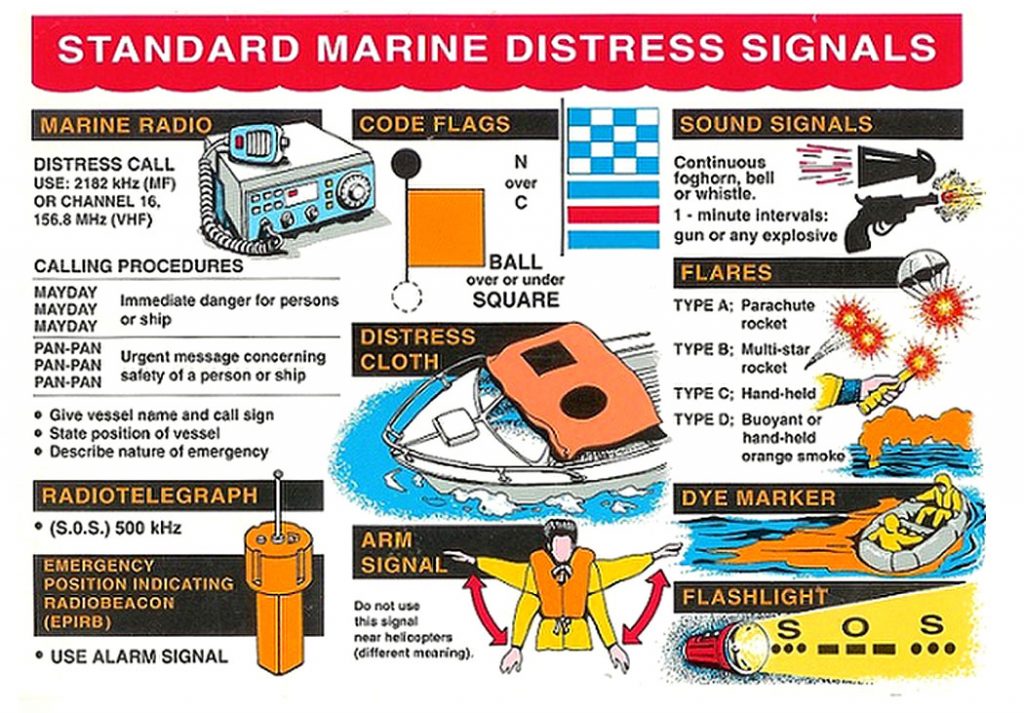It’s Easy As ABC and 123 * * * Previously we talked about the proper use of the ship’s radio for both standard communications and in emergency situations. However, emergencies can occur at times when neither radios nor cell phones can be used due to power outages, reception quality, or a lack of network connectivity. In these situations, distress signals are the next option. This safety tip discusses each distress signal. A – The most popular signals are orange-colored signal flares, smoke markers, and die markers. B – Rocket flares have the greatest visibility due to the altitude they achieve. C – Hand-held flares are highly visible as well, but can be blocked by points of land or high waves when viewed from a distance. D – Flares can be seen during daylight and at times when visibility is restricted. E – Dye markers are best seen by air rescue vehicles in daylight. In addition to pyrotechnic and dye options, sound signals and light signals are available. F – A continuous sounding of a boat’s horn is an effective audio signal. You can improve horn signals by using the horn to sound an SOS blast (short, short, short; prolonged, prolonged, prolonged; short, short, short). G – Megaphones and Loud Hailers also send distress signals. H – While not common, firing a gun at one-minute intervals is a distress signal. I – At night a powerful flashlight can be used to attract attention by flashing an SOS signal. J – Recently, battery-operated floating strobe lights that flash an SOS signal have been approved. These work well at night, but during daylight, they can be confused with the sun’s reflections off of a choppy sea. K – A burning barrel of oil on deck is a lighted distress signal. While recreational boats won’t have a barrel of oil on board, a gas-fired BBQ can be lit up. Manual Distress Signals … These can attract the attention of a passing vessel. L – Extending your arms from side to side while waving them upward and downward is a distress signal. M – Flying the code flag for November above the code flag for Charlie as a distress signal. N – If you don’t have code flags you can fly a distress cloth. A distress cloth is a rectangular piece of orange cloth showing a black square and a black ball. This signal is most often used to help air rescue vehicles spot your boat. To properly display this distress signal tie it down on the bow, the Bimini, or hardtop.

Lastly, we have electronic options. These distress signals come in 3 varieties. O – An Emergency Position Indicating Radio Beacon (EPIRB) is commonly known. EPIRBs are carried on ships. In an emergency, the EPIRB will automatically send a distress signal to a dedicated satellite network. This device broadcasts its location and identifies the vessel to which it is registered. P – An Emergency Locator Transmitter (ELT) is used on aircraft and performs the same function as an EPIRB does for a ship. Q – A Personal Locator Beacon (PLB) is carried by an individual. When activated a PLB identifies its location and identifies the person to whom it is registered. Beacons equipped with GPS can pinpoint a location within a 100-meter radius. Units without GPS achieve a radius of 3 nautical miles. Be a Good Samaritan … A long-standing law of the sea requires that a skipper must bring aid to a vessel in distress. However, in doing so he or she should not put their vessel and the ship’s crew into a dangerous situation. Therefore, should you come upon a vessel in distress and see, or hear a distress signal, you should take immediate, positive, and appropriate action. Your first action would be to establish communication with the distressed vessel following these guidelines. 1 – Using a loud hailer of the ship’s radio contact the distressed vessel. 2 – Ask the distressed vessel’s skipper if he or she needs assistance or has called Sea Tow, or Boat US for assistance. 3 – If yes standby until their assistance arrives. 4 – If no ask what the nature of the problem is. 5 – Find out how many passengers are on board. 6 – Take note of the length, color ad number of the ship. 7 – Ask if anyone requires medical attention. 8 – Ask if they are taking on water. 9 – Have everyone on board put on a life jacket. 10 – Ask where the skipper needs to take his boat. 11 – Notify the nearest Coast Guard station or State authority by radio. Channel 9 on CB and Channel 16 on VHF marine radio (156.8 MHz) are recognized distress channels. 12 – If you can assist the stricken vessel without endangering yourself or your crew, you can render the necessary help as a Good Samaritan. The Federal Boat Safety Act of 1971 contains a “Good Samaritan” clause stating: “Any person ….who gratuitously and in good faith renders assistance at the scene of a vessel collision, accident, or other casualties without objection of any person assisted, shall not be held liable for any act or omission in providing or arranging salvage, towage, medical treatment, or other assistance where the assisting person acts as an ordinary, reasonably prudent man or woman would have acted under the same or similar circumstances.
You can learn more from Captain Steve Stolze by visiting BoatOpsAndSafety.com.
While there, explore the site and navigate through Captain Stormalong’s Tall Tales Blog.
Remember, Smart Boating is Safe Boating!!
